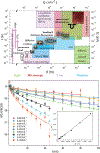Transverse lipid organization dictates bending fluctuations in model plasma membranes
- PMID: 31746906
- PMCID: PMC11577542
- DOI: 10.1039/c9nr07977g
Transverse lipid organization dictates bending fluctuations in model plasma membranes
Abstract
Membrane undulations play a vital role in many biological processes, including the regulation of membrane protein activity. The asymmetric lipid composition of most biological membranes complicates theoretical description of these bending fluctuations, yet experimental data that would inform any such a theory is scarce. Here, we used neutron spin-echo (NSE) spectroscopy to measure the bending fluctuations of large unilamellar vesicles (LUV) having an asymmetric transbilayer distribution of high- and low-melting lipids. The asymmetric vesicles were prepared using cyclodextrin-mediated lipid exchange, and were composed of an outer leaflet enriched in egg sphingomyelin (ESM) and an inner leaflet enriched in 1-palmitoyl-2-oleoyl-phosphoethanolamine (POPE), which have main transition temperatures of 37 °C and 25 °C, respectively. The overall membrane bending rigidity was measured at three temperatures: 15 °C, where both lipids are in a gel state; 45 °C, where both lipids are in a fluid state; and 30 °C, where there is gel-fluid co-existence. Remarkably, the dynamics for the fluid asymmetric LUVs (aLUVs) at 30 °C and 45 °C do not follow trends predicted by their symmetric counterparts. At 30 °C, compositional asymmetry suppressed the bending fluctuations, with the asymmetric bilayer exhibiting a larger bending modulus than that of symmetric bilayers corresponding to either the outer or inner leaflet. We conclude that the compositional asymmetry and leaflet coupling influence the internal dissipation within the bilayer and result in membrane properties that cannot be directly predicted from corresponding symmetric bilayers.
Conflict of interest statement
Conflicts of interest
There are no conflicts to declare.
Figures



References
-
- Bell RM, Ballas LM and Coleman RA, J. Lipid Res, 1981, 22, 391–403. - PubMed
-
- Pomorski T, Hrafnsdóttir S, Devaux PF and van Meer G, Semin. Cell Dev. Biol, 2001, 12, 139–148. - PubMed
-
- Kol MA, de Kroon AI, Killian JA and de Kruijff B, Biochemistry, 2004, 43, 2673–2681. - PubMed
-
- Devaux PF and Morris R, Traffic, 2004, 5, 241–246. - PubMed
MeSH terms
Substances
Grants and funding
LinkOut - more resources
Full Text Sources

